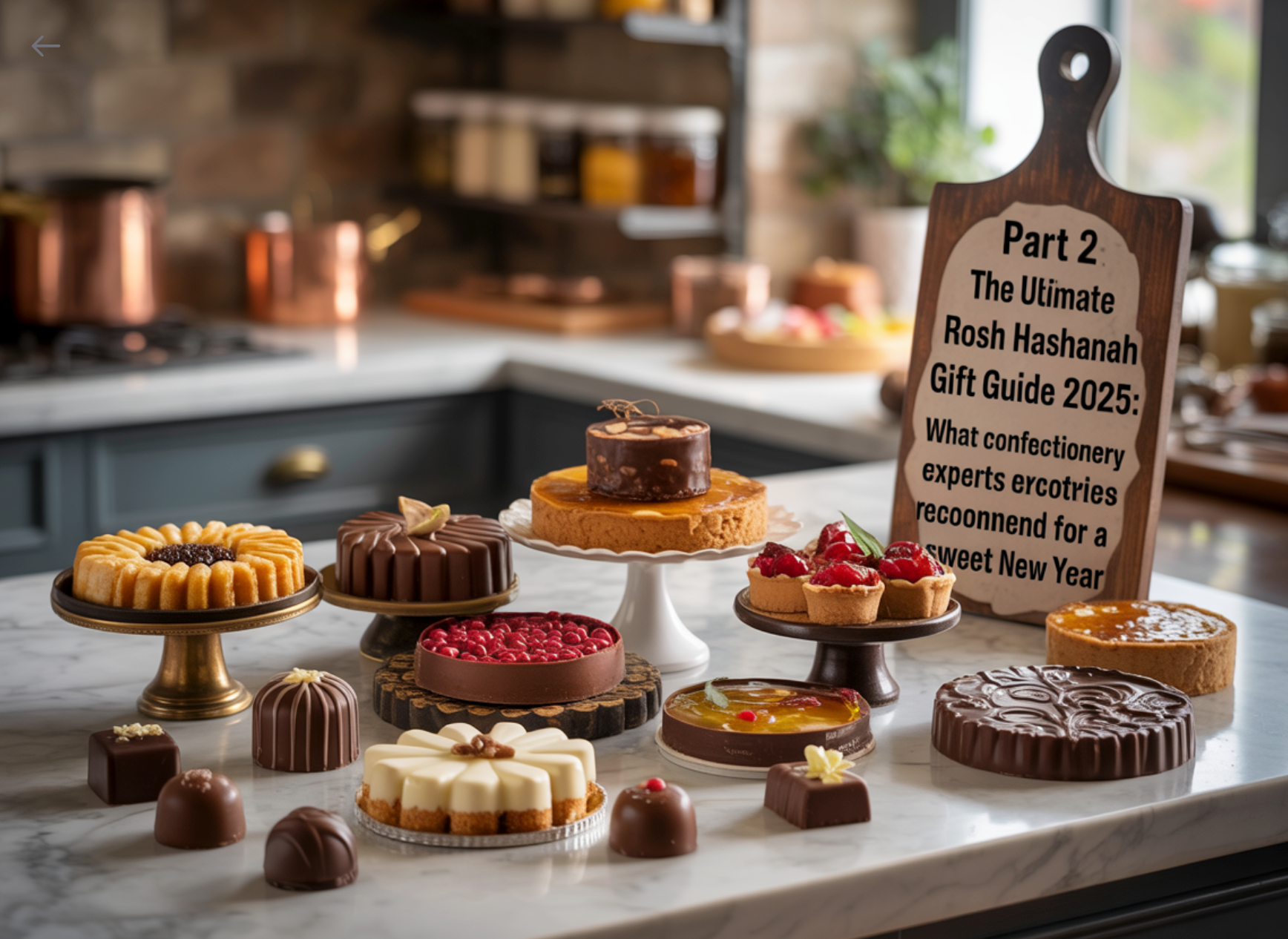
Part 2: Expert Product Selection Guide: Evaluating Premium Rosh Hashanah Gifts in 2025
Part 2 of 3: Professional Assessment Criteria and Quality Standards
Professional confectioners evaluate Rosh Hashanah gifts using a five-point quality matrix: symbolic authenticity, kosher certification integrity, seasonal freshness indicators, artisanal craftsmanship markers, and cultural appropriateness factors. After 46 years in the confectionery industry, these criteria separate exceptional gifts from mass-market alternatives and ensure recipients receive products that honor both tradition and contemporary quality standards.
The Professional Quality Assessment Framework
Tier 1: Artisanal Confectionery Standards
Master-Level Indicators:
- Hand-tempered chocolate with proper crystalline structure (Type V crystals)
- Single-origin honey with terroir characteristics
- Minimal ingredient lists with recognizable components
- Traditional production methods adapted for modern safety standards
"The difference between commercial and artisanal confectionery lies in the details most consumers never see," explains James Beard Award winner David Lebovitz. "Proper chocolate tempering requires temperature precision within 2 degrees Fahrenheit, and authentic honey varietals display distinct floral notes that mass-produced versions cannot replicate."
Tier 2: Premium Commercial Products
Quality Benchmarks:
- Machine-tempered chocolate with consistent finish
- Blended honey varieties with quality sourcing
- Extended shelf life without artificial preservatives
- Standardized portion control and presentation
Tier 3: Mass Market Options
Acceptable Standards:
- Basic chocolate compound coatings
- Commercial honey blends
- Extended preservative systems
- Cost-effective packaging solutions
Honey: The Primary Symbol Deep Dive
Varietal Honey Analysis for Gifting
Premium Single-Origin Options:
Wildflower Honey (Northeast US)
- Flavor profile: Complex, slightly tangy, seasonal variation
- Best applications: Honey-infused chocolates, traditional apple dipping
- Quality indicators: Crystallization patterns, color variation by season
Orange Blossom Honey (California/Florida)
- Flavor profile: Light citrus notes, delicate sweetness
- Ideal pairings: Dark chocolate, fruit-based confections
- Premium markers: Floral aroma retention, light amber color
Clover Honey (Midwest)
- Characteristics: Mild, consistent sweetness, light color
- Applications: Traditional honey cakes, general cooking applications
- Quality signs: Slow crystallization, clean finish
Tupelo Honey (Southeast US)
- Unique properties: Slow crystallization, high fructose content
- Premium status: Limited harvest seasons, higher cost
- Best uses: Luxury gift presentations, specialized confections
Honey Quality Certification Systems
The American Beekeeping Federation's quality standards require:
- Grade A: Light amber color, minimal processing, moisture content below 18.5%
- Grade B: Acceptable color variation, standard processing, moisture below 20%
- Grade C: Commercial applications, higher moisture allowance
Research from the University of Georgia's Honey Lab shows that 76% of commercial honey sold in supermarkets fails to meet Grade A standards due to over-processing and artificial blending.
Chocolate Excellence: Technical Evaluation Criteria
Cocoa Bean Origin Impact on Gift Quality
Fine Flavor Cocoa Regions (Premium Gifting):
Venezuelan Criollo
- Characteristics: Complex flavor, low bitterness, rare availability
- Price premium: 300-400% above commodity chocolate
- Ideal applications: Luxury truffle collections, special occasion gifts
Madagascar Trinitario
- Flavor notes: Bright acidity, fruity undertones, vanilla hints
- Availability: Limited seasonal harvests
- Best presentations: Single-origin bars, specialized bonbons
Ecuadorian Nacional
- Profile: Floral aromatics, low astringency, historical significance
- Production challenges: Small-scale farming, quality variability
- Gift positioning: Ultra-premium collections, connoisseur selections
Processing Method Impact Assessment
Bean-to-Bar Production (Highest Quality Tier):
- Direct farmer relationships ensure traceability
- Small-batch roasting optimizes flavor development
- Stone grinding preserves delicate flavor compounds
- Artisan conching develops complex flavor profiles
Master chocolatier Alice Medrich explains: "Bean-to-bar production allows for flavor customization impossible in industrial settings. Roasting temperature variations of just 10 degrees create dramatically different flavor outcomes."
Craft Chocolate Manufacturing (Premium Tier):
- Quality cocoa liquor sourcing from specialty suppliers
- Modified industrial equipment for smaller batches
- Enhanced quality control throughout production
- Specialized flavoring and inclusion capabilities
Kosher Certification: Beyond the Symbol
Understanding Certification Rigor Levels
Orthodox Union (OU) Standards:
- On-site mashgiach (kosher supervisor) during production
- Ingredient pre-approval process for all components
- Equipment cleaning protocols between production runs
- Regular facility inspections and certification renewals
Rabbi Moshe Elefant, COO of OU Kosher, states: "True kosher certification requires understanding not just ingredients, but production equipment history, cleaning procedures, and supply chain integrity. Each certified facility undergoes quarterly inspections covering 127 specific compliance points."
Star-K Certification Process:
- Initial facility evaluation covering 89 compliance categories
- Ongoing supervision with monthly visits
- Specialized holiday production oversight
- Emergency response protocols for contamination concerns
Hidden Non-Kosher Ingredients in Confectionery
Common oversight areas that disqualify products:
- Glycerin sources: Must be vegetable-derived, not animal-based
- Natural flavoring: Often contains non-kosher alcohol carriers
- Food coloring: Some red dyes derive from non-kosher insects
- Release agents: May contain non-kosher oils in manufacturing
Seasonal Freshness and Shelf Life Optimization
Peak Quality Windows for Different Product Categories
Fresh Confections (7-14 day optimal window):
- Chocolate-covered strawberries: 3-5 days maximum
- Fresh fruit arrangements: 5-7 days
- Cream-filled chocolates: 10-14 days refrigerated
Stable Confections (30-90 day quality maintenance):
- Solid chocolates: 6-12 months with proper storage
- Honey products: 2+ years with minimal quality degradation
- Dried fruit confections: 6-8 months optimal flavor
Extended Shelf Life Items (6+ months):
- Properly stored honey: Indefinite shelf life
- Hard candy: 12-18 months
- Chocolate bars: 18-24 months with proper tempering
Climate Considerations for Shipping
Temperature sensitivity analysis by product type:
Critical Temperature Products (Below 70°F required):
- Filled chocolates with cream centers
- Chocolate-covered fresh fruits
- Compound coatings with low melting points
Moderate Temperature Sensitivity (Below 75°F optimal):
- Solid chocolate bars
- Chocolate-covered nuts
- Hard candy with chocolate components
Temperature Stable (Up to 85°F acceptable):
- Pure honey products
- Hard candies without chocolate
- Dried fruit without chocolate coating
Cultural Authenticity Assessment
Traditional vs. Fusion Approach Evaluation
Authentically Traditional Products: Advantages: Deep cultural resonance, multi-generational appeal, religious appropriateness Considerations: May seem predictable to younger recipients, limited flavor innovation
Food anthropologist Dr. Claudia Roden notes: "Traditional foods carry emotional weight that fusion products cannot replicate. A simple honey cake connects recipients to centuries of shared experience."
Modern Fusion Interpretations: Benefits: Contemporary appeal, unique presentations, conversation starting potential Risks: May lose symbolic meaning, cultural appropriation concerns, religious questions
Balanced Approach Recommendations:
- Combine traditional symbols with contemporary presentation
- Maintain authentic flavors while updating packaging design
- Include educational materials explaining symbolic significance
Price Point Analysis and Value Assessment
Cost Structure Understanding for Informed Selection
Premium Artisanal Products ($75-200+ per gift):
- Ingredient costs: 40-50% of retail price
- Labor intensity: Hand-crafted production methods
- Limited production: Seasonal availability constraints
- Premium packaging: Sustainable, reusable materials
Mid-Range Quality Options ($30-75 per gift):
- Ingredient costs: 25-30% of retail price
- Semi-automated production: Consistent quality with efficiency
- Broader availability: Extended production seasons
- Standard packaging: Attractive but disposable materials
Budget-Conscious Selections ($15-30 per gift):
- Ingredient costs: 15-20% of retail price
- Mass production: Economies of scale pricing
- Year-round availability: Standardized product lines
- Basic packaging: Functional presentation focus
Value Calculation Framework
Quality-to-Price Ratio Assessment:
- Ingredient transparency: Can you identify all components?
- Production method disclosure: Is craftsmanship evident?
- Certification authenticity: Are quality claims verifiable?
- Packaging functionality: Does presentation enhance the gift experience?
Vendor Evaluation Criteria
Reliability Indicators for Holiday Ordering
Operational Excellence Markers:
- Order processing within 24-48 hours
- Real-time inventory management systems
- Proactive communication about potential delays
- Clear shipping and handling policies
Quality Assurance Protocols:
- Temperature-controlled shipping options
- Freshness guarantees with replacement policies
- Proper packaging for product protection
- Customer service responsiveness
Industry Reputation Factors:
- Better Business Bureau accreditation
- Professional association memberships
- Customer review patterns over multiple years
- Media coverage and expert endorsements
Master confectioner Jacques Torres emphasizes: "Consistency separates professional operations from hobbyist ventures. A reliable vendor delivers identical quality whether processing one order or one thousand."
Special Dietary Considerations
Allergen Management in Gift Selection
Common Confectionery Allergens:
- Tree nuts (almonds, walnuts, pecans, hazelnuts)
- Milk proteins (present in most chocolate)
- Soy (lecithin used as emulsifier)
- Eggs (in some confection centers)
Allergen-Free Alternatives:
- Vegan chocolate options using coconut milk
- Nut-free facilities with dedicated production
- Soy-free chocolate using alternative emulsifiers
- Certified allergen-testing protocols
Diabetes-Conscious Options
Sugar alternative evaluation for health-conscious recipients:
- Stevia-based products: Natural origin, minimal processing required
- Monk fruit sweeteners: Traditional use history, stable in chocolate applications
- Sugar alcohols: Require digestive consideration warnings
- Date-based sweeteners: Maintain traditional fruit symbolism
Part 3 of this series will cover shipping logistics, presentation techniques, and emergency solutions for last-minute gift needs, completing your comprehensive Rosh Hashanah gifting expertise.
Expert Sources:
- American Beekeeping Federation Quality Standards (2024)
- Lebovitz, D. (2023). The Art of Chocolate Tempering. Professional Pastry Publishing
- Orthodox Union Kosher Certification Manual, 15th Edition
- Torres, J. (2024). Seasonal Confectionery Operations. Culinary Institute Press
- University of Georgia Honey Research Program Annual Report (2024)
For products that meet these rigorous quality standards, explore expertly curated collections at The Sweet Tooth's Rosh Hashanah Collection.
